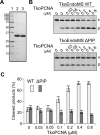Identification of a mismatch-specific endonuclease in hyperthermophilic Archaea
- PMID: 27001046
- PMCID: PMC4838380
- DOI: 10.1093/nar/gkw153
Identification of a mismatch-specific endonuclease in hyperthermophilic Archaea
Abstract
The common mismatch repair system processed by MutS and MutL and their homologs was identified in Bacteria and Eukarya. However, no evidence of a functional MutS/L homolog has been reported for archaeal organisms, and it is not known whether the mismatch repair system is conserved in Archaea. Here, we describe an endonuclease that cleaves double-stranded DNA containing a mismatched base pair, from the hyperthermophilic archaeon Pyrococcus furiosus The corresponding gene revealed that the activity originates from PF0012, and we named this enzyme Endonuclease MS (EndoMS) as the mismatch-specific Endonuclease. The sequence similarity suggested that EndoMS is the ortholog of NucS isolated from Pyrococcus abyssi, published previously. Biochemical characterizations of the EndoMS homolog from Thermococcus kodakarensis clearly showed that EndoMS specifically cleaves both strands of double-stranded DNA into 5'-protruding forms, with the mismatched base pair in the central position. EndoMS cleaves G/T, G/G, T/T, T/C and A/G mismatches, with a more preference for G/T, G/G and T/T, but has very little or no effect on C/C, A/C and A/A mismatches. The discovery of this endonuclease suggests the existence of a novel mismatch repair process, initiated by the double-strand break generated by the EndoMS endonuclease, in Archaea and some Bacteria.
© The Author(s) 2016. Published by Oxford University Press on behalf of Nucleic Acids Research.
Figures








Similar articles
-
Activation of the mismatch-specific endonuclease EndoMS/NucS by the replication clamp is required for high fidelity DNA replication.Nucleic Acids Res. 2018 Jul 6;46(12):6206-6217. doi: 10.1093/nar/gky460. Nucleic Acids Res. 2018. PMID: 29846672 Free PMC article.
-
Structure of the EndoMS-DNA Complex as Mismatch Restriction Endonuclease.Structure. 2016 Nov 1;24(11):1960-1971. doi: 10.1016/j.str.2016.09.005. Epub 2016 Oct 20. Structure. 2016. PMID: 27773688
-
Bacterial EndoMS/NucS acts as a clamp-mediated mismatch endonuclease to prevent asymmetric accumulation of replication errors.Nucleic Acids Res. 2018 Jul 6;46(12):6152-6165. doi: 10.1093/nar/gky481. Nucleic Acids Res. 2018. PMID: 29878158 Free PMC article.
-
Control of Genome Stability by EndoMS/NucS-Mediated Non-Canonical Mismatch Repair.Cells. 2021 May 25;10(6):1314. doi: 10.3390/cells10061314. Cells. 2021. PMID: 34070467 Free PMC article. Review.
-
An overview of 25 years of research on Thermococcus kodakarensis, a genetically versatile model organism for archaeal research.Folia Microbiol (Praha). 2020 Feb;65(1):67-78. doi: 10.1007/s12223-019-00730-2. Epub 2019 Jul 8. Folia Microbiol (Praha). 2020. PMID: 31286382 Review.
Cited by
-
Conservation and diversity of radiation and oxidative stress resistance mechanisms in Deinococcus species.FEMS Microbiol Rev. 2019 Jan 1;43(1):19-52. doi: 10.1093/femsre/fuy037. FEMS Microbiol Rev. 2019. PMID: 30339218 Free PMC article. Review.
-
The mesophilic archaeon Methanosarcina acetivorans counteracts uracil in DNA with multiple enzymes: EndoQ, ExoIII, and UDG.Sci Rep. 2018 Oct 25;8(1):15791. doi: 10.1038/s41598-018-34000-x. Sci Rep. 2018. PMID: 30361558 Free PMC article.
-
The protein structurome of Orthornavirae and its dark matter.mBio. 2025 Feb 5;16(2):e0320024. doi: 10.1128/mbio.03200-24. Epub 2024 Dec 23. mBio. 2025. PMID: 39714180 Free PMC article.
-
Characterization of a Novel Thermostable DNA Lyase Used To Prepare DNA for Next-Generation Sequencing.Chem Res Toxicol. 2023 Feb 20;36(2):162-176. doi: 10.1021/acs.chemrestox.2c00172. Epub 2023 Jan 16. Chem Res Toxicol. 2023. PMID: 36647573 Free PMC article.
-
The Impact of Single-Stranded DNA-Binding Protein SSB and Putative SSB-Interacting Proteins on Genome Integrity in the Thermophilic Crenarchaeon Sulfolobus acidocaldarius.Int J Mol Sci. 2023 Feb 25;24(5):4558. doi: 10.3390/ijms24054558. Int J Mol Sci. 2023. PMID: 36901989 Free PMC article.
References
-
- Barnes D.E., Lindahl T. Repair and genetic consequences of endogenous DNA base damage in mammalian cells. Annu. Rev. Genet. 2004;38:445–476. - PubMed
-
- Reardon J.T., Sancar A. Nucleotide excision repair. Prog. Nucleic Acid Res. Mol. Biol. 2005;79:183–235. - PubMed
-
- Iyer R.R., Pluciennik A., Burdett V., Modrich P.L. DNA mismatch repair: functions and mechanisms. Chem. Rev. 2006;106:302–323. - PubMed
Publication types
MeSH terms
Substances
LinkOut - more resources
Full Text Sources
Other Literature Sources
Miscellaneous

